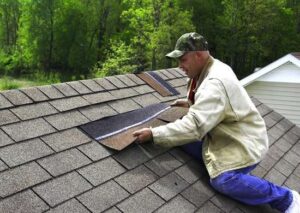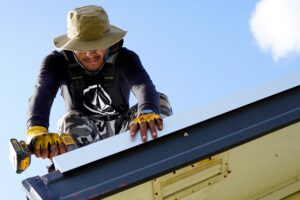Your roof offers your home the ultimate protection. It takes a beating from snow, rain, and intense heat. Regular inspections are important.

Minor repairs are easy and inexpensive if caught early. Look for leaking spots, water damage, and sagging areas, and check gutters and downspouts for proper drainage. Also, inspect the flashing around chimneys and roof windows.
Shingles are your roof’s first line of defense against the elements. Wind, hail, snow, sun exposure, and old age can all take their toll on individual shingles or an entire section of your roof. When a shingle is damaged, it can let water in and cause problems like rot or mold. If you rescue loose shingles regularly and make quick repairs when necessary, you can get much more life out of your shingles.
To repair a damaged shingle, start by assessing the area and determining what needs to be done. You’ll need to climb on the roof to access the affected area, so you should always use a ladder that is securely set up and secured, with someone watching it from below.
Once on the roof, locate the shingle that’s missing or damaged. If it’s simply cracked or torn, you don’t need to replace it; a simple bead of sealant should do the trick. To do this, apply a bead of roof sealant under the damaged shingle, and then press it down.
Next, use a flat pry bar to loosen the nail that holds the damaged shingle in place. Then, carefully remove the shingle and the nail. If the shingle is torn, you’ll want to replace it with another shingle from a hidden part of your roof (or buy a bundle at a home repair store).
You should also apply a bead of roof cement around the damaged area, and then re-nail it. Be sure to use a galvanized nail to prevent rust. If you’re unsure how to do this, it may be best to call in a professional.
When it comes to face nails (nails that go into the side of a shingle instead of through the top), you should never “face nail” a shingle where it will be exposed to the elements-it breaks the waterproof seal and will allow water to seep underneath the shingles and cause damage. If you have to face nail a shingle, be sure to put sealant over the exposed nail head.
Flashing
Many elements of building construction go unnoticed, but some perform critical tasks that prevent water from entering a structure. One of those is flashing, thin sheets that line and protect crevices where structures like chimneys, dormers, vent pipes, and skylights penetrate roofs. In addition, they protect the areas around these structures from leaks.
Roof flashing is usually made of galvanized steel, aluminum, or copper. It is installed on top of underlayment and shingle sheathing. It is most often placed in areas where leaking is more likely to occur, such as along roof edges, the area where two slopes meet (roof valleys), and where chimneys, plumbing vents, skylights, and other features protrude through the roof. Flashing is also used to line and seal the area where a wall meets a ceiling.
There are a variety of types of roof flashing, including base flashing, apron flashing, counter flashing, and pipe flashing. Each type has a different purpose and installation procedure, but they all work to protect against leaks. Base flashing, for instance, is installed underneath shingles to ensure that rainwater always meets a flashing surface that directs it downward. Apron flashing is installed next to base flashing, forming an L-shape to create a more protective barrier. Counter flashing is then installed above the apron flashing to complete the two-part system.
Depending on the materials, a roofing contractor will use specific flashing to install around chimneys and other protrusions. For example, if a dormer window is being added to a roof with a steep slope, it will require step flashing, which consists of multiple squares of metal bent into an L-shape. This method lines the joint with the roof and the wall, ensuring that it is completely waterproof.
During a roofing inspection, a qualified contractor will check the condition of the flashing to make sure it is intact and free from holes or corroded spots. If any of these materials need to be replaced, a professional will remove the old flashing and apply new material to prevent leaks. They will also caulk or tar any exposed areas, and replace any missing shingles.
Gutters
Gutters are shallow troughs fixed beneath the edge of the roof to channel rainwater away from the house. They are an important part of a roof system because they prevent water from pooling around the foundation or walls, which can cause expensive repairs. They also prevent soil erosion and damage to the foundation and home. Gutters should be cleaned regularly to avoid clogging.
Gutter systems are usually made of steel, aluminum or vinyl and come in both seamless and sectional styles. They may require readjustment, extensions and splash blocks to ensure proper function. If a gutter is sagging or severely damaged, it should be replaced immediately to avoid leaks and other problems.
Leaks can occur at the gutter seams, end caps or along the length of the gutters. Depending on the type of gutter, these leaks can be patched with silicon caulk or metal flashing. It is best to hire a professional for gutter repair, as it can be dangerous to climb on the roof to perform this task.
In addition to repairing and maintaining gutters, roofers can also help with the installation of new gutters. They will help you choose the best gutter materials for your climate, and install them correctly to avoid future problems. They can also recommend a maintenance schedule to keep your gutters in good shape.
The main reason for gutter maintenance is to remove debris, such as leaves and twigs, before it can clog the gutters and cause water damage. In addition, regular cleanings can reduce the risk of pest infestation. Pests are attracted to ponding water, which can be caused by clogged gutters. This is especially true for homes with wood siding, as the standing water can damage the wood. In addition, the bugs and insects that are attracted to ponding water can eventually enter the house. In order to avoid these problems, it is recommended that you have your gutters cleaned by a professional twice per year. During the cleaning process, they will inspect the gutters for any signs of damage. They will also clean the downspouts and the splash blocks.
Downspouts
A downspout (also called a drain spout, downpipe, roof drain pipe, or leader) carries rainwater from the gutters to the ground. It’s essential in a properly functioning gutter system, because without one, water would soak through the shingles and cause damage to the fascia board, and other parts of your home. Downspouts also help keep the ground around your house dry, which protects it from soil erosion and helps prevent basement flooding.
Clogged gutters are a common problem, and can be caused by a variety of things. The most common reason is a buildup of leaves, twigs and other debris. It’s important to clean your gutters regularly, ideally twice per year–once in the late Spring and once in the Fall. If you live in an area that receives a lot of precipitation, you may need to clean your gutters more frequently.
You can do a simple downspout cleaning by removing the gutter and using a hose to spray the downspout to remove any buildup. However, if the downspout is clogged and isn’t carrying water away from your house, it’s time for a more involved fix.
Usually, this involves a downspout extension. These are pieces of plastic or metal that attach to the end of your downspout and extend it so that water is further away from your house. They’re especially useful in areas where the ground slopes towards your foundation, as they can prevent water from pooling and potentially damaging the foundation of your house.
The first step in repairing a downspout extension is to measure from the end of your downspout to the ground and subtract about a foot, so that you have enough room for the bottom of the extender. Next, cut a piece of downspout material to the appropriate length with your hacksaw, and attach it to the downspout by fitting one elbow over the drop outlet and another at the bottom of the downspout. Finally, add a short piece of downspout that connects the two elbows at a slanted angle so that water flows through them.
If your downspout is leaking at the bottom, it’s probably due to a loose or missing connector. Fortunately, this is a relatively easy DIY job, and if it’s not done, it could lead to costly water damage. You can find replacement connectors at most home improvement stores.


